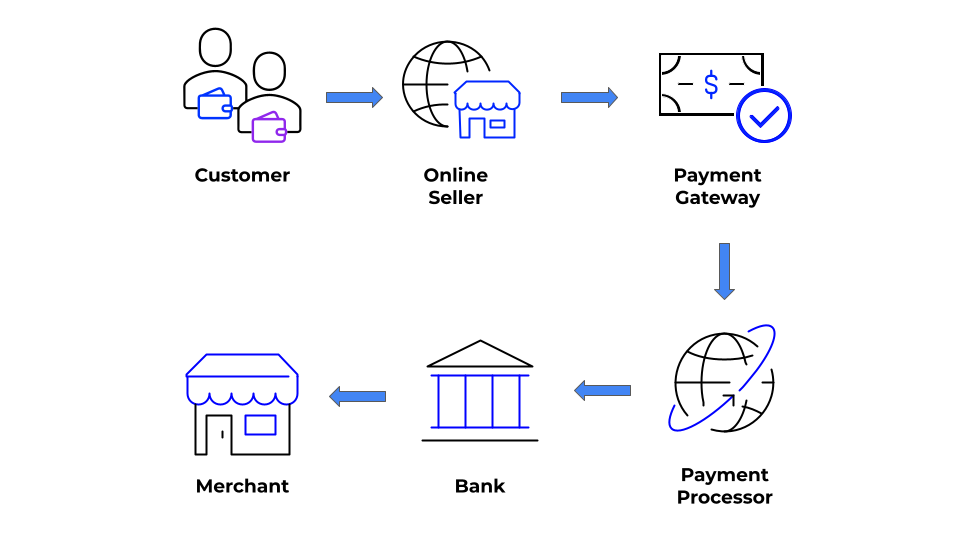Payment processing services have come a long way since the days of ‘cash or card?’. Here’s everything you need to know about accepting online payments.
From credit cards to technologies like digital wallets and real-time bank transfers, these days consumers have a wide choice when it comes to paying for goods online. offering a range of locally preferred payment methods is part of delivering a great customer experience. That’s why payment processing technology that supports customers’ preferred payment methods is vitally important to online merchants everywhere. If you are a merchant trying to make sense of payment processing terminology or just trying to learn what you need to accept payments in-store or online, then this article is for you.
Payments 101: How Online Payment Processing Works
How Online Payment Processing Works
The process of making an online payment probably seems simple to consumers as they shop, but there are a number of different steps that have to go on behind the scenes:
- Customer selects payment method at checkout
- It’s encrypted via a payment gateway and sent to the payment processor
- The sale is authorized
- The transaction is approved by the customer’s card issuer, bank or digital wallet
- Funds are sent to the merchant bank, less the payment processing fees


How Cross-Border Payment Processing Works
While it’s understood that international sales are important for business growth, the actual process of accepting cross-border payments is something not all merchants feel confident about. Selling in multiple countries and locations means that funds will be received in multiple currencies. Those funds will need to be exchanged, and that’s why the best ecommerce payment processing software offers foreign exchange (FX) and single currency settlement, which makes trading globally much easier.
Consumers across the world generally have their own preferred payment methods, depending on what is most common or even just what’s available in their particular location. Understanding preferred local payment methods in the countries where you’re selling is important, as is being able to accept a full range of local payment methods.
Cross-border transactions are also more likely to result in declined cards, another reason for accepting alternative payment methods like bank transfers and digital wallets. And the risk of fraud is higher, so using a solution that offers effective fraud protection that’s designed for cross-border commerce is important.
Online Payment Processing Fees
It’s important to be aware of the potential fees involved in offering online payments, which can include the following:
- The fee charged by the card issuer or payment method provider
- The fee charged by the credit card association
- The fee charged by the merchant bank for processing the transaction
- The authorization fee—a flat amount charged by the payment processor for each transaction (whether approved, declined or returned)
There are of course ways to ensure you’re getting the most value from your payment processing system. Merchants should look for a payment processor that charges a simple, low rate per transaction with no setup fees.
Global ACH Payment Processing
The Automated Clearing House (ACH) network is a system for processing electronic transactions in the US, with transfers made between banks. Unlike real-time payments, it’s a batch-processing system with payment batches processed and sent a few times per day. Certain payment types are more suited for the ACH system, recurring payouts such as salaries and monthly memberships.
International payments can be sent and received through Global ACH. And though ACH payment processing might not always be suitable, particularly for situations that require funds to be settled quickly, there are certainly benefits to merchants trading internationally. For example, costs are often lower, it can improve customer experience by offering an alternative payment method and merchants avoid credit card chargeback risks.
How to Add Payment Processing to Your Website
To be able to accept payments from online customers, whether locally or globally, you need to add payment processing to your website. There are a number of ways this can be done:
-
- API Integration: Rapyd Collect API is a flexible solution that lets you accept hundreds of different international payment methods across 100+ countries.
- Pre-Built Hosted Checkout: Rapyd’s Pre-Built Checkout can be customized to fit your business, and lets customers shop with you using their locally preferred payment methods.
- eCommerce Platform Plugins: An easy way of accepting cross-border payments is to use a plugin for ecommerce platforms like WooCommerce, Shopify, Magento and Wix
- Digital Invoicing: If you want to quickly enable payment acceptance with no coding or integrations, you can use no-code invoicing to simply send your customers a digital invoice with payment methods built-in.
All of these online Payment Processing solutions will make it easier for you to accept cross-border payments from international customers, helping your business to expand wherever you want it to grow. In order to build and maintain a global customer base you need to offer a fast, convenient and frictionless payment experience, and Rapyd can help you do just that.


